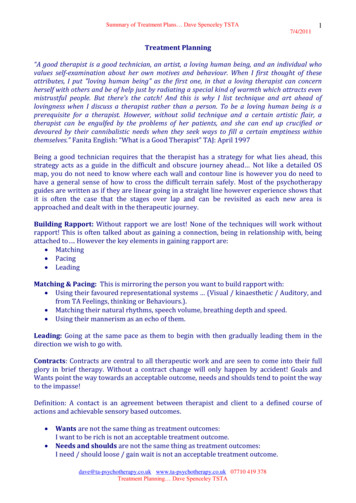
Transcription
Summary of Treatment Plans Dave Spenceley TSTA17/4/2011Treatment Planning“A good therapist is a good technician, an artist, a loving human being, and an individual whovalues self-examination about her own motives and behaviour. When I first thought of theseattributes, I put "loving human being" as the first one, in that a loving therapist can concernherself with others and be of help just by radiating a special kind of warmth which attracts evenmistrustful people. But there's the catch! And this is why I list technique and art ahead oflovingness when I discuss a therapist rather than a person. To be a loving human being is aprerequisite for a therapist. However, without solid technique and a certain artistic flair, atherapist can be engulfed by the problems of her patients, and she can end up crucified ordevoured by their cannibalistic needs when they seek ways to fill a certain emptiness withinthemselves.” Fanita English: “What is a Good Therapist” TAJ: April 1997Being a good technician requires that the therapist has a strategy for what lies ahead, thisstrategy acts as a guide in the difficult and obscure journey ahead Not like a detailed OSmap, you do not need to know where each wall and contour line is however you do need tohave a general sense of how to cross the difficult terrain safely. Most of the psychotherapyguides are written as if they are linear going in a straight line however experience shows thatit is often the case that the stages over lap and can be revisited as each new area isapproached and dealt with in the therapeutic journey.Building Rapport: Without rapport we are lost! None of the techniques will work withoutrapport! This is often talked about as gaining a connection, being in relationship with, beingattached to . However the key elements in gaining rapport are: Matching Pacing LeadingMatching & Pacing: This is mirroring the person you want to build rapport with: Using their favoured representational systems (Visual / kinaesthetic / Auditory, andfrom TA Feelings, thinking or Behaviours.). Matching their natural rhythms, speech volume, breathing depth and speed. Using their mannerism as an echo of them.Leading: Going at the same pace as them to begin with then gradually leading them in thedirection we wish to go with.Contracts: Contracts are central to all therapeutic work and are seen to come into their fullglory in brief therapy. Without a contract change will only happen by accident! Goals andWants point the way towards an acceptable outcome, needs and shoulds tend to point the wayto the impasse!Definition: A contact is an agreement between therapist and client to a defined course ofactions and achievable sensory based outcomes. Wants are not the same thing as treatment outcomes:I want to be rich is not an acceptable treatment outcome.Needs and shoulds are not the same thing as treatment outcomes:I need / should loose / gain wait is not an acceptable treatment outcome.dave@ta-psychotherapy.co.uk www.ta-psychotherapy.co.uk 07710 419 378Treatment Planning Dave Spenceley TSTA
Summary of Treatment Plans Dave Spenceley TSTA27/4/2011 Goals are not acceptable treatment outcomes :My goal is to have a new job.A treatment contract will have visible verifiable outcomes and will look something like: I will get a new job: I will apply for new jobs until I get one: I make this a two way process by agreeing what the client will do and what I will do asthe therapist.The above contract contains both the outcome (a new job) and the action.Cure is seen as the fulfilment of the contractWarning: Watch out for fake contracts, which are not about change .These include slipperywords such as Try, able to. No change contracts are often ways used to maintain the client in astuck place.“I will try to make the changes I need so that I will be able to get the work I need.”Eric Berne: Four stages of Cure: (1961 TA psychotherapy in Action)1. Social control: In this situation the client carries out the actions which werepreviously avoided.2. Symptomatic relief: in which the client no longer feels the fear associated with theprevious difficulty.3. Transference cure: in which the client appears to reach autonomy, however this isonly in response to the transference with the therapist.4. Script cure: in which the person reaches autonomy. (Is this possible? Yes for manydifficulties but I don’t think we ever actually self-actualise not unless we are a saintor an eastern master?).Berne’s 4 stages of the Treatment Sequence:1. Structural Analysis2. Transactional Analysis3. Game Analysis4. Script AnalysisBerne developed this theme in his writing to end with the following sequence:1. Preliminary Phase: Initial Interview Business Contract2. Script Analysis3. Script Antithesis4. Redecision:Berne’s (1966) Therapeutic Operations: (See also Charlotte Sills and HelanaHargadens’s book TA a Relational Therapy where they have changed the name toempathic interventions and added an 9th intervention of holding)1. Interrogation (Asking questions)2. Specification (Repeating what the client has said to clear it and to add moreinformation)3. Confrontation (Pointing out inconsistencies)dave@ta-psychotherapy.co.uk www.ta-psychotherapy.co.uk 07710 419 378Treatment Planning Dave Spenceley TSTA
Summary of Treatment Plans Dave Spenceley TSTA37/4/20114.5.6.7.8.9.Explanations (The therapist says what they think is going on)Illustrations (Metaphors etc)Confirmations (Confirming the clients Adult thinking)Interpretation (Aimed at deconfusing the Child ego state)Holding Therapeutic holding within the relational therapeutic work.Crystallisation (Adult – Adult, bringing together all 3 ego states of the client preparingto make a redecision)Ian Stewart (TA Counselling in Action) points out that treatment direction and planning isalways based on the interplay between 3 aspects of the work:1. The diagnosis2. The contract3. The choice of interventions, both long term and short term actions, noting the choice ofattention to both process and content.4. I add to a further trio: The 3 P’s as: Crossman)a. Potencyb. Protectionc. PermissionsRichard Erskine: Six Stages of Treatment: (TAJ July 1973)1. Defensive2. Anger3. Hurt4. Self as a Problem5. Taking Responsibility6. Parents are forgiven.McCormick and Pulleyblank: 7 Stages of Redecision Therapy: Redecision Therapyexpanded ion of Early transactions through experience.Exploration of the early transactions and the decisions madeExploration of advantages and disadvantages of staying with the early decision.RedecisionPracticing the new decision.Petruska Clarkson: TA Psychotherapy and Integrated Approach1. Establishing a working relationship2. Contracting3. Decontamination (Adult ego state work)4. Deconfusion (Child ego state work)5. Establish an internal Nurturing Parent6. Emotional fluency7. Redecision work8. Parent ego state work9. Rechildingdave@ta-psychotherapy.co.uk www.ta-psychotherapy.co.uk 07710 419 378Treatment Planning Dave Spenceley TSTA
Summary of Treatment Plans Dave Spenceley TSTA47/4/201110. Reorientation11. Relearning12. TerminationWoollams & Brown: Transactional Analysis1. Motivation2. Awareness3. Treatment Contract4. Deconfusing the Child5. Redecision6. Relearning7. TerminationThe four rules of therapy: (could be deal with the Process . 1st , 2nd, 3rd, 4thetc .and I would add . Always trust the process!)a) The therapist should remain in an Ok position during and after therapy.b) Deal with the structure of the relationship between therapist and clientbefore dealing with the content of the contract.c) Deal with the transference and counter transference issues before dealingwith the content of the contract.d) Deal with any here and now issues between the client and the therapist orother group members before dealing with the content of the contract .Dave Spenceley:1.2.3.4.5.6.7.8.Contact, establish a therapeutic relationship and alliance:Motivation:Specify the problem.State the desired outcome:ContractRe-experience the past noticing the advantages and disadvantages of no change.Experience the future noticing the advantages and disadvantages of no change.Make the change: Redecision / decontamination / deconfusion and Parent ego statework.9. Anchor the change in the future:10. Practice itdave@ta-psychotherapy.co.uk www.ta-psychotherapy.co.uk 07710 419 378Treatment Planning Dave Spenceley TSTA
Summary of Treatment Plans Dave Spenceley TSTA57/4/2011Contact, establish a therapeutic relationshipand allianceMotivation:Specify the problem.State the desired outcome:ContractRe-experience the past noticing the advantagesand disadvantages of no change.Experience the future noticing the advantagesand disadvantages of no change.Make changes: Redecision / decontamination /deconfusion . this can be seen as workingtowards change within each of the 3 ego states:Anchor the change in the future:Practice it;.TAJ reading list:Michele Novellino TAJ: July 1985Redecision analysis of transference; A TA approach to transference neurosis.Transference neurosis is discussed from a TA perspective. Mellor's (1980) developmentalmodel of impasses is considered as a useful way to analyze transference andcountertransference phenomena. Clinical examples are given and treatment planning isillustrated.William F. Cornell TAJ: Jan 1986Setting the therapeutic stage; The initial session.This article addresses the question of what we teach our clients - directly and indirectly aboutthe nature of psychotherapeutic work through the process of the initial interview(s). Threecentral purposes for the initial interview are discussed: engaging the client in a mutualdave@ta-psychotherapy.co.uk www.ta-psychotherapy.co.uk 07710 419 378Treatment Planning Dave Spenceley TSTA
Summary of Treatment Plans Dave Spenceley TSTA67/4/2011collaboration, establishing the therapeutic canon, and giving equal attention to assessing aclient's strengths/competencies and difficulties. Notes on the clinical supervision of the initialinterview are also included.Vann Joines TAJ: July 1988Diagnosis and treatment planning using a transactional analysis framework.Transactional analysis is an excellent tool for effective diagnosis and treatment planning.When integrated with the concepts of individuation and attachment, script types, andpersonality adaptations, the OK Corral (Ernst, 1971) offers clinicians a comprehensivediagnostic and treatment guide. When combined with contracting, the therapist and clienttogether can formulate a treatment plan that is clear, direct, and enjoyable.Petruska Clarkson TAJ: July 1988Script Cure? A diagnostic pentagon in different types of therapeutic change:Although there are scattered references to different psychotherapy outcomes through-outBerne's work, nowhere does he bring them together for comparison, contrast, andconfirmation; nor does he show how possible psychotherapy outcomes can be systematicallyidentified and described. This article presents five possible outcomes: Script Cure, MakingProgress, Disintegration, Disillusionment, and Counterscript Cure. These "faces of change" arediscussed as five separate systems with their own frames of reference, including idiosyncraticmotivations for seeking/avoiding future changes, characteristic response patterns, anddiffering capacities in managing stress. Each is associated with an archetypal or mythologicalimage which may aid the psychotherapist in distinguishing, defining, and recognizing the fivetypes of outcome so that he or she can facilitate life script changes that are genuine, stableunder stress, and provide a fertile and resilient ground for future growth. A pentagon diagramsummarizes these major points.Landy Gobes TAJ: Jan 1993.C4P4 A consultation checklist:The C4P4 Checklist-(Contact, Contract, Context, Content, Process, Parallel process,Professional level of development, and Plan for the future)-is both an organizing techniqueand a memory aid for consultants. Consultation is differentiated from supervision andtraining.Keith Tudor TAJ: July 1995What do you say about saying goodbye? Ending Psychotherapy:This article identifies issues related to ending psychotherapy and suggests an addition toBerne's (1966) three methods of termination. Drawing on the professional literatureconcerning transactional analysis, dying, death, mourning, and bereavement, the authoroutlines seven tasks in the process of ending TA psychotherapy.Gordon Hewitt TAJ: July 1995Cycles of psychotherapyThis article proposes a system for classifying psychotherapy, counselling, and supervision interms of a cycle of four phases. The author describes each phase and the boundary conditionthat indicates the client is ready to move to the next phase, as well as the tasks of therapistand client at each phase. The effects of premature passage to the next phase of treatment ortermination at an inappropriately early phase are also discussed. The phases, with theirboundary conditions in brackets, are: contact (contract), content (decision or redecision),consolidation (integration), and conclusion (termination or reengagement).dave@ta-psychotherapy.co.uk www.ta-psychotherapy.co.uk 07710 419 378Treatment Planning Dave Spenceley TSTA
dave@ta-psychotherapy.co.uk www.ta-psychotherapy.co.uk 07710 419 378 Treatment Planning Dave Spenceley TSTA 6 collaboration, establishing the therapeutic canon, and giving equal attention to assessing a client's strengths/competencies and difficulties. Notes on the clinical supervision of the initial interview are also included.










